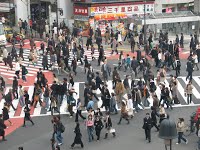1. Japanese Society in the first decade of the 21st Century.
Click here: Japan Perspective 1
After a prolonged period of painful adjustment following the collapse of the bubble economy around 1990, the economy returned to moderate growth around 2002. But the events of 2008 has once again plunged Japan Japanese society had changed. Old values were eroding, unemployment had risen sharply, the birth rate is the lowest in the world, and millions of young people feel alienated. The national debt has spun out of control, exacerbated by questionable pork barrel schemes. Relations with China and Korea have worsened alarmingly. The political right is in the ascendant. Badly needed educational reform is bogged down in controversy.
2. Caught between two Cultures
Click here: Japan Perspective 1
Japan's century-old conundrum—how to reconcile its deliberate Western leanings with its Asian roots—has not been solved by its advanced technology, economic success and mass overseas travel. Many Japanese feel they belong nowhere.
3. The Social Cost of the Construction State
Click here: Japan Perspective 1
Massive pork-barrel works: roads, bridges, the concreting of river beds and coastlines - often in sparsely populated areas, have destroyed much natural beauty and wildlife and caused an astronomical national debt. Cosy relations between government, the bureaucracy and the construction lobby are to blame.
4. Threats to Stability
Click here: Japan Perspective 1
Huge anti-gvernment demonstrations in 1960; novelist Yukio Mishima's 1970 attempt to cause an uprising among the military, and his suicide; the bizarre activities of the "Red Army Faction" in 1972; ; the heinous sarin gas attack on subway passengers by a "religious" sect committed to "cleansing the world" in 1995; and North Korea's firing of a missile across Japan in 1998.
5. Society’s drop-outs and the new free-lancers
Click here: Japan Perspective 1
Millions of men and women in their 20s and 30s have turned their back on established social norms and traditional career patterns. Some are self-employed. Most make a modest living as part-time workers, or live off the fruits of their parents’ hard work. Perhaps a million are hermits.
6. Suicides: over 30,000 a year
Click here: Japan Perspective 1
Japan's suicide rate is among the highest in the developed world. Illness and poverty are aleading cause, but in recent years losing one's job and pessimism about the future have considerably raised the numbers.
7. The identity issue
Click here: Japan Perspective 2
The Japanese are unusually preoccupied with their identity as a people and as individuals. Their search has spawned a library of books on 'Japaneseness'. The weakening of the traditional group culture and family values confronts many with the need to find their own identity.
8. Attitudes and Opinions. A survey
Click here: Japan Perspective 2
Results of a written survey on lifestyles, employment preferences, educational standards, the monarchy, and other topics. A cross-section of 100 Japanese. Plus discussions with another 25. In eight parts.
9. The Overflowing Cup - A Zen Experience
Click here: Zen Experience
Detailed account of Hans Brinckmann's 1960s stays in Zen temples in Kyoto and Yokohama, and discussions with Zen masters.
10. Text of speech at Foreign Correspondents Club of Japan, Tokyo
Click here: Japan Perspective 3
On 15 February 2005 Hans Brinckmann introduced his The Magatama Doodle - One Man's Affair with Japan, 1950-2004, at the FCCJ. The book's Japanese translation was acclaimed in the leading daily Asahi Shimbun and many other publications. Text of his speech and of the Q & A that followed.
11. 'From shibumi to super-brands: the lost values of Showa', a lecture
Click here: Japan Perspective 3
There is a current nostalgia in Japan for the Showa era (which ended in 1989) - its values of hard work, sober tastes and social cohesion. This fond perception contrasts sharply with a growing income gap, apathy among the young and widespread pursuit of a materialistic lifestyle in Japan today. The speaker explored the implications of the loss of 'Showa values'. (Text of Brinckmann's lecture to the Japan Society, London, 12 September 2005.)
12. Erasmus/De Liefde: The story of the first Dutch ship to arrive in Japan, AD 1600
Click here: Erasmus/De Liefde
The first Dutch ship to arrive in Japan was De Liefde, which dropped anchor off Kyushu in April, 1600, after a harrowing, two-year voyage, with only 24 of its 110 crew still alive. What was the purpose of this perilous journey, and why did the ship carry a carving of the Rotterdam humanist Erasmus on its stern? Where is that carving now? An account of a fascinating piece of history. (Text of Brinckmann's lecture at the Tokyo National Museum, 12 November, 2008, under auspices of the Japan-Netherlands Society).
13. 'Showa Japan, seen through Dutch eyes', exhibition of over 130 photographs at Fuji Film Square, Tokyo Midtown, Tokyo, August 29 to September 30, 2008.
The event attracted over 49,000 visitors.
Click here: FujiFilmExhibition
14. Photo exhibition at the Foreign Correspondents Club of Japan, Tokyo, January 18 to February 28 2009.
This was a smaller version of 'Showa Japan, seen through Dutch eyes', exhibition at Fuji Film Square, in September, 2008.
Click here: FCCJExhibition














